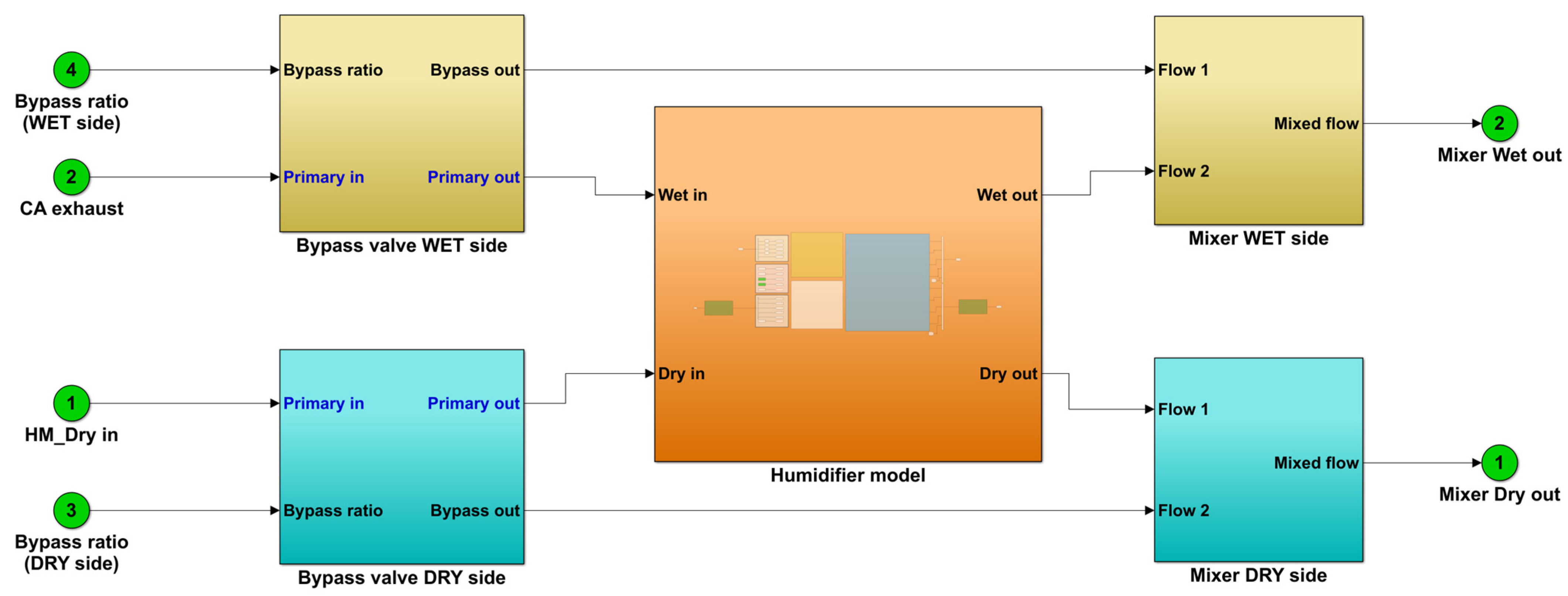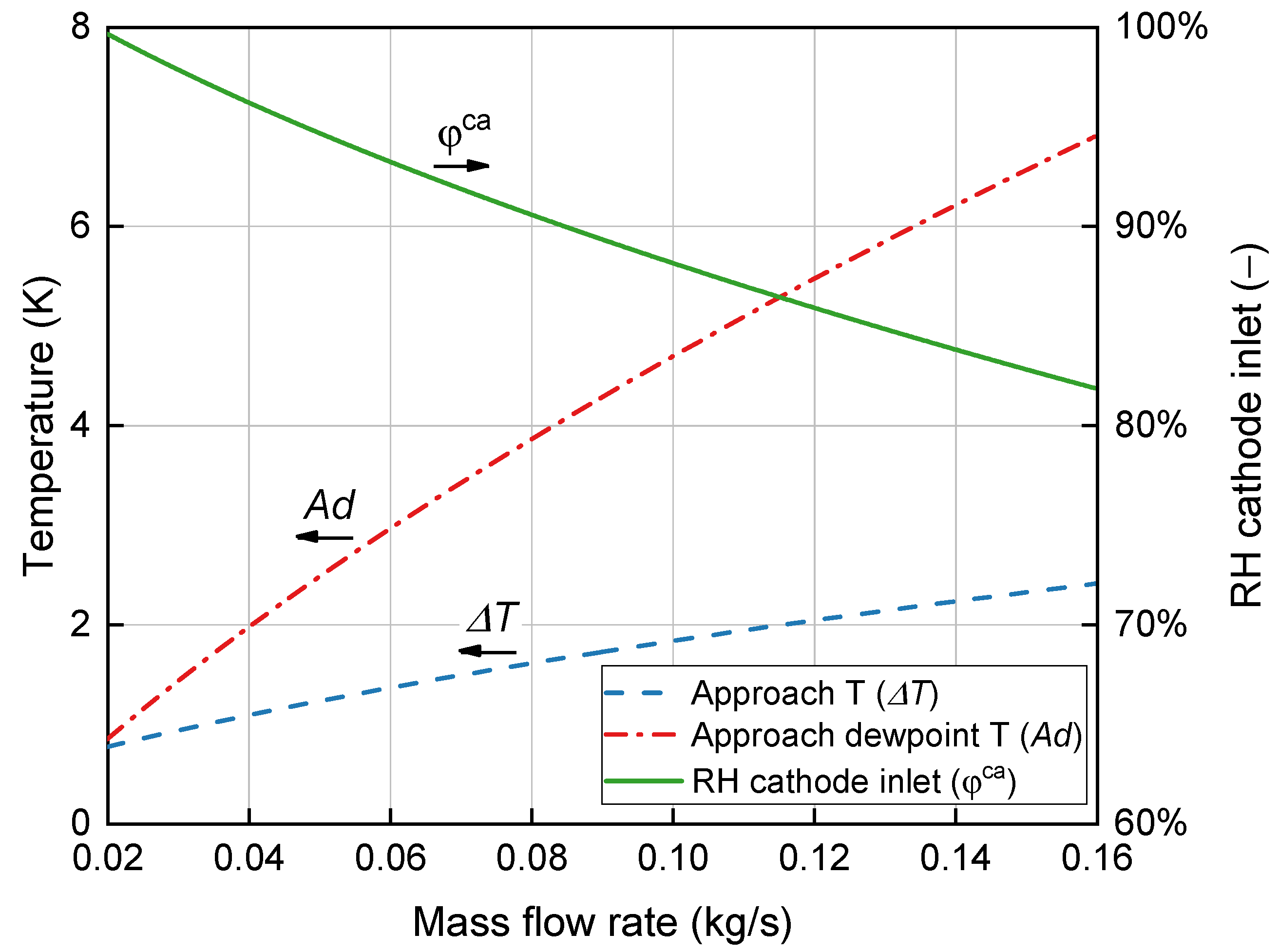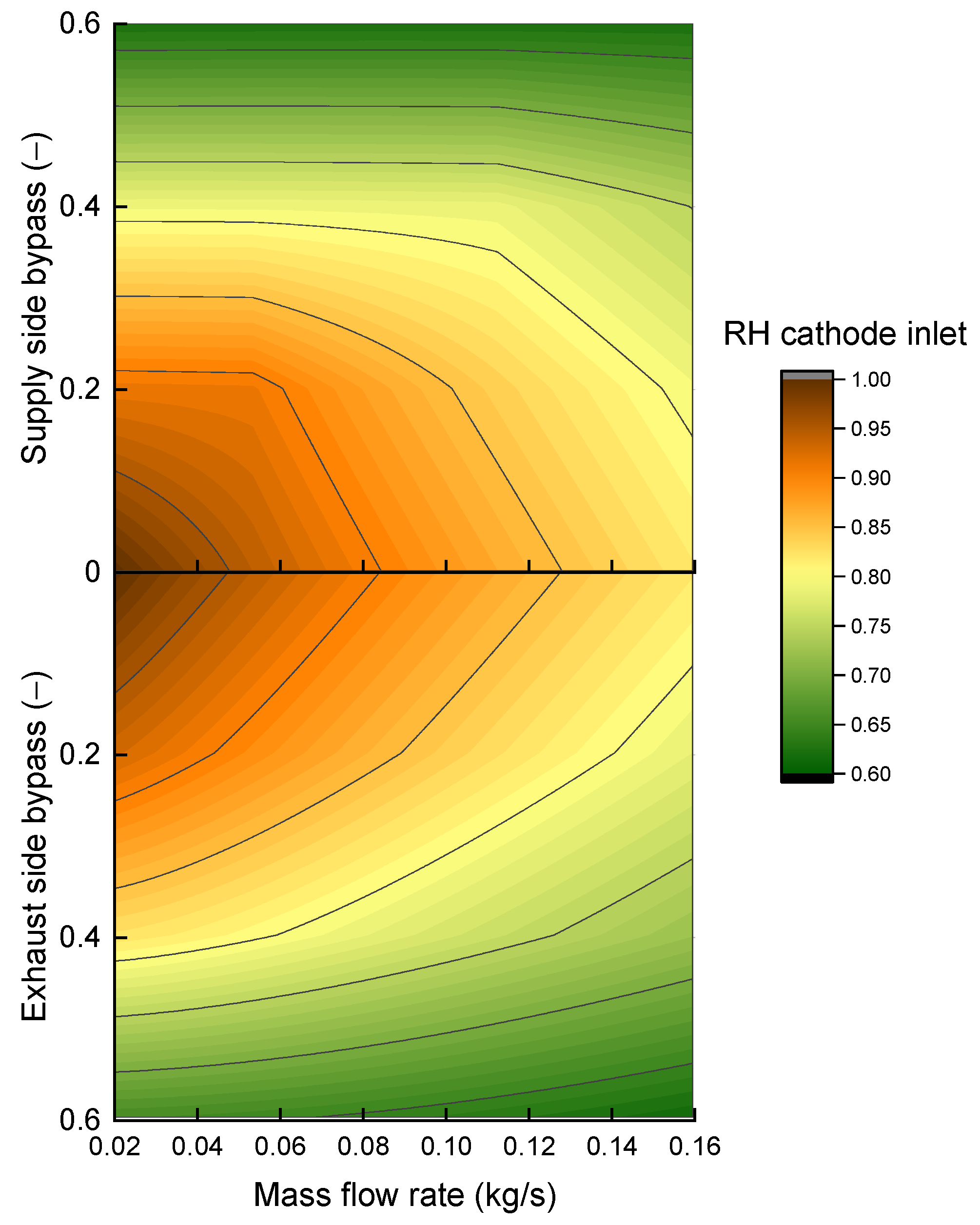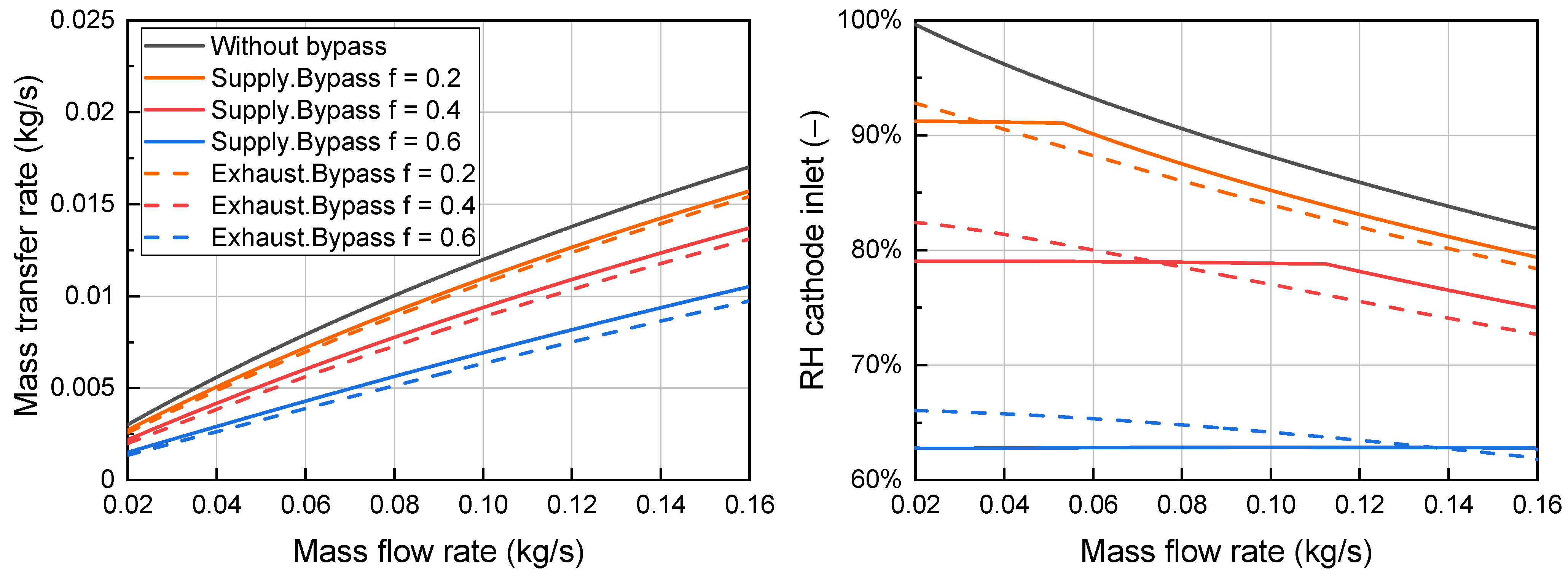Bypass Configurations of Membrane Humidifiers for Water Management in PEM Fuel Cells
Abstract
:1. Introduction
2. Model Descriptions
2.1. Membrane Humidifier
- The flows are perfectly distributed in the shell and tubes;
- Effects of tube-to-tube heat and mass transfer are neglected to focus on the shell-and-tube exchange;
- The transportation is considered perpendicular to the flow directions, while the transportation in parallel with the flow is negligible;
- Counterflow arrangement is fully developed inside the shell and tubes, and therefore, the heat and mass transfer follow counterflow correlations at all parts along the flows.
2.2. Bypass Valve and Mixer
2.3. Fuel Cell Stack
2.3.1. Anode Channel
2.3.2. Cathode Channel
2.3.3. Membrane Water Transport
2.3.4. Electrochemistry
2.4. Simulation
3. Discussions
3.1. Effects of Mass Flow Rate and Bypass Fraction
3.1.1. Humidifier Performance with Increasing Load Demand
3.1.2. Flow Rate Adjustments with Humidifier Bypass
3.2. Effects of Humidifier Size
3.3. Integration into the Fuel Cell System
4. Conclusions
Author Contributions
Funding
Data Availability Statement
Acknowledgments
Conflicts of Interest
Nomenclature
| area | |
| approach dewpoint temperature | |
| heat capacity | |
| heat capacity ratio | |
| membrane thickness | |
| diameter | |
| diffusion coefficient | |
| Faraday’s constant | |
| bypass fraction | |
| gravitational acceleration | |
| convective heat transfer | |
| current density | |
| electric conductivity | |
| mass flow rate | |
| molar flow rate | |
| number of membranes | |
| electro-osmotic coefficient | |
| number of transfer units for heat transfer analysis | |
| open-circuit voltage | |
| pressure | |
| heat transfer rate | |
| thickness | |
| temperature | |
| dewpoint temperature | |
| overall heat transfer coefficient | |
| voltage | |
| molar fraction | |
| distance | |
| Greek letters | |
| water concentration | |
| effectiveness | |
| overpotential | |
| membrane water content | |
| density | |
| membrane conductivity | |
| relative humidity | |
| specific humidity | |
| Subscripts and superscripts | |
| dry air | |
| anode | |
| bypass | |
| fuel cell | |
| cathode | |
| catalyst layer | |
| exhaust gas from cathode | |
| effective | |
| manifold | |
| heat transfer | |
| inlet | |
| membrane/mass transfer | |
| minimum | |
| maximum | |
| outlet | |
| production | |
| reaction | |
| supply air | |
| saturation | |
| transfer | |
| total flow rate | |
| vapor | |
| water | |
References
- Jiao, K.; Xuan, J.; Du, Q.; Bao, Z.; Xie, B.; Wang, B.; Zhao, Y.; Fan, L.; Wang, H.; Hou, Z.; et al. Designing the next Generation of Proton-Exchange Membrane Fuel Cells. Nature 2021, 595, 361–369. [Google Scholar] [CrossRef] [PubMed]
- Hassan, N.S.M.; Daud, W.R.W.; Sopian, K.; Sahari, J. Water Management in a Single Cell Proton Exchange Membrane Fuel Cells with a Serpentine Flow Field. J. Power Sources 2009, 193, 249–257. [Google Scholar] [CrossRef]
- Chen, B.; Wang, J.; Yang, T.; Cai, Y.; Zhang, C.; Chan, S.H.; Yu, Y.; Tu, Z. Carbon Corrosion and Performance Degradation Mechanism in a Proton Exchange Membrane Fuel Cell with Dead-Ended Anode and Cathode. Energy 2016, 106, 54–62. [Google Scholar] [CrossRef]
- Yan, S.; Yang, M.; Sun, C.; Xu, S. Liquid Water Characteristics in the Compressed Gradient Porosity Gas Diffusion Layer of Proton Exchange Membrane Fuel Cells Using the Lattice Boltzmann Method. Energies 2023, 16, 6010. [Google Scholar] [CrossRef]
- Al-Bonsrulah, H.A.Z.; Alshukri, M.J.; Mikhaeel, L.M.; Al-Sawaf, N.N.; Nesrine, K.; Reddy, M.V.; Zaghib, K. Design and Simulation Studies of Hybrid Power Systems Based on Photovoltaic, Wind, Electrolyzer, and Pem Fuel Cells. Energies 2021, 14, 2643. [Google Scholar] [CrossRef]
- Eriksson, E.L.V.; Gray, E.M.A. Optimization and Integration of Hybrid Renewable Energy Hydrogen Fuel Cell Energy Systems—A Critical Review. Appl. Energy 2017, 202, 348–364. [Google Scholar] [CrossRef]
- Chang, Y.; Qin, Y.; Yin, Y.; Zhang, J.; Li, X. Humidification Strategy for Polymer Electrolyte Membrane Fuel Cells—A Review. Appl. Energy 2018, 230, 643–662. [Google Scholar] [CrossRef]
- Park, S.; Jung, D. Effect of Operating Parameters on Dynamic Response of Water-to-Gas Membrane Humidifier for Proton Exchange Membrane Fuel Cell Vehicle. Int. J. Hydrogen Energy 2013, 38, 7114–7125. [Google Scholar] [CrossRef]
- Pukrushpan, J.T.; Stefanopoulou, A.G.; Peng, H. Fuel Cell System Model: Auxiliary Components BT. In Control of Fuel Cell Power Systems: Principles, Modeling, Analysis and Feedback Design; Pukrushpan, J.T., Stefanopoulou, A.G., Peng, H., Eds.; Springer: London, UK, 2004; pp. 15–29. ISBN 978-1-4471-3792-4. [Google Scholar]
- Park, S.; Oh, I.-H. An Analytical Model of NafionTM Membrane Humidifier for Proton Exchange Membrane Fuel Cells. J. Power Sources 2009, 188, 498–501. [Google Scholar] [CrossRef]
- Park, S.-K.; Choe, S.-Y.; Choi, S. Dynamic Modeling and Analysis of a Shell-and-Tube Type Gas-to-Gas Membrane Humidifier for PEM Fuel Cell Applications. Int. J. Hydrogen Energy 2008, 33, 2273–2282. [Google Scholar] [CrossRef]
- Ozen, D.N.; Timurkutluk, B.; Altinisik, K. Effects of Operation Temperature and Reactant Gas Humidity Levels on Performance of PEM Fuel Cells. Renew. Sustain. Energy Rev. 2016, 59, 1298–1306. [Google Scholar] [CrossRef]
- Jeong, S.U.; Cho, E.A.; Kim, H.J.; Lim, T.H.; Oh, I.H.; Kim, S.H. Effects of Cathode Open Area and Relative Humidity on the Performance of Air-Breathing Polymer Electrolyte Membrane Fuel Cells. J. Power Sources 2006, 158, 348–353. [Google Scholar] [CrossRef]
- Jamekhorshid, A.; Karimi, G.; Noshadi, I. Current Distribution and Cathode Flooding Prediction in a PEM Fuel Cell. J. Taiwan Inst. Chem. Eng. 2011, 42, 622–631. [Google Scholar] [CrossRef]
- Janicka, E.; Mielniczek, M.; Gawel, L.; Darowicki, K. Optimization of the Relative Humidity of Reactant Gases in Hydrogen Fuel Cells Using Dynamic Impedance Measurements. Energies 2021, 14, 3038. [Google Scholar] [CrossRef]
- Bergman, T.L.; Lavine, A.S.; Incropera, F.P.; DeWitt, D.P. Fundamentals of Heat and Mass Transfer, 8th ed.; Wiley: New York, NY, USA, 2018; ISBN 978-1-119-35388-1. [Google Scholar]
- Zhang, L.Z. An Analytical Solution for Heat Mass Transfer in a Hollow Fiber Membrane Based Air-to-Air Heat Mass Exchanger. J. Membr. Sci. 2010, 360, 217–225. [Google Scholar] [CrossRef]
- Vu, H.N.; Nguyen, X.L.; Yu, S. A Lumped-Mass Model of Membrane Humidifier for PEMFC. Energies 2022, 15, 2113. [Google Scholar] [CrossRef]
- Nguyen, X.L.; Vu, H.N.; Yu, S. Parametric Understanding of Vapor Transport of Hollow Fiber Membranes for Design of a Membrane Humidifier. Renew. Energy 2021, 177, 1293–1307. [Google Scholar] [CrossRef]
- Lawrence, M.G. The Relationship between Relative Humidity and the Dewpoint Temperature in Moist Air: A Simple Conversion and Applications. Bull. Am. Meteorol. Soc. 2005, 86, 225–233. [Google Scholar] [CrossRef]
- Cengel, Y.A.; Boles, M.A. Thermodynamics: An Engineering Approach; McGraw-Hill Education: New York, NY, USA, 2015; ISBN 9780073398174 0073398179. [Google Scholar]
- Dutta, S.; Shimpalee, S.; Van Zee, J.W. Numerical Prediction of Mass-Exchange between Cathode and Anode Channels in a PEM Fuel Cell. Int. J. Heat Mass Transf. 2001, 44, 2029–2042. [Google Scholar] [CrossRef]
- Pukrushpan, J.T.; Stefanopoulou, A.G.; Peng, H. Fuel Cell System Model: Fuel Cell Stack. In Control of Fuel Cell Power Systems: Principles, Modeling, Analysis and Feedback Design; Pukrushpan, J.T., Stefanopoulou, A.G., Peng, H., Eds.; Springer: London, UK, 2004; pp. 31–56. ISBN 978-1-4471-3792-4. [Google Scholar]
- O’Hayre, R.; Cha, S.-W.; Colella, W.; Prinz, F.B. Chapter 4: Fuel Cell Charge Transport. In Fuel Cell Fundamentals; John Wiley & Sons, Inc.: Hoboken, NJ, USA, 2016; pp. 117–166. [Google Scholar]
- Springer, T.E.; Zawodzinski, T.A.; Gottesfeld, S. Polymer Electrolyte Fuel Cell Model. J. Electrochem. Soc. 1991, 138, 2334–2342. [Google Scholar] [CrossRef]
- Vu, H.N.; Truong Le Tri, D.; Nguyen, H.L.; Kim, Y.; Yu, S. Multifunctional Bypass Valve for Water Management and Surge Protection in a Proton-Exchange Membrane Fuel Cell Supply-Air System. Energy 2023, 278, 127696. [Google Scholar] [CrossRef]
- Truong Le Tri, D.; Vu, H.N.; Nguyen, H.L.; Kim, Y.; Yu, S. A Comparative Study of Single and Dual Ejector Concepts for Anodic Recirculation System in High-Performance Vehicular Proton Exchange Membrane Fuel Cells. Int. J. Hydrogen Energy 2023, 48, 27344–27360. [Google Scholar] [CrossRef]







| Parameter | Unit | Values |
|---|---|---|
| Membrane inner diameter | mm | 0.9 |
| Membrane thickness | mm | 0.1 |
| Number of membranes | - | 13,000 |
| Membrane length | mm | 254 |
| Membrane thermal conductivity | W/(mK) | 0.2 |
| Vapor diffusivity in membrane | m2/s | 3.7 × 10−6 |
| Vapor diffusivity in air | m2/s | 2.82 × 10−5 |
| Parameter | Unit | Value |
|---|---|---|
| Number of cells | - | 404 |
| Cell active area | cm2 | 380 |
| Cell length | m | 0.195 |
| Cell width | m | 0.195 |
| Number of channels | - | 32 |
| Depth of gas channel | m | 0.001 |
| Width of gas channel | m | 0.001 |
| Membrane thickness | mm | 0.127 |
| Anode volume | m3 | 0.005 |
| Cathode volume | m3 | 0.01 |
| Case | Fixed Parameters | Varied Parameters | Simulation Purposes |
|---|---|---|---|
| 1 | Effects of supply air flow rate (demand changes) on humidified flow | ||
| 2 | Effects of bypass configurations and bypass fractions on humidified flow | ||
| 3 | Effects of humidifier size on humidified flow | ||
| 4 | Current demand Inlet flows’ characteristics depend on the current demand | Humidifier responses in system integration |
Disclaimer/Publisher’s Note: The statements, opinions and data contained in all publications are solely those of the individual author(s) and contributor(s) and not of MDPI and/or the editor(s). MDPI and/or the editor(s) disclaim responsibility for any injury to people or property resulting from any ideas, methods, instructions or products referred to in the content. |
© 2023 by the authors. Licensee MDPI, Basel, Switzerland. This article is an open access article distributed under the terms and conditions of the Creative Commons Attribution (CC BY) license (https://creativecommons.org/licenses/by/4.0/).
Share and Cite
Vu, H.N.; Trinh, D.H.; Truong Le Tri, D.; Yu, S. Bypass Configurations of Membrane Humidifiers for Water Management in PEM Fuel Cells. Energies 2023, 16, 6986. https://doi.org/10.3390/en16196986
Vu HN, Trinh DH, Truong Le Tri D, Yu S. Bypass Configurations of Membrane Humidifiers for Water Management in PEM Fuel Cells. Energies. 2023; 16(19):6986. https://doi.org/10.3390/en16196986
Chicago/Turabian StyleVu, Hoang Nghia, Dinh Hoang Trinh, Dat Truong Le Tri, and Sangseok Yu. 2023. "Bypass Configurations of Membrane Humidifiers for Water Management in PEM Fuel Cells" Energies 16, no. 19: 6986. https://doi.org/10.3390/en16196986
APA StyleVu, H. N., Trinh, D. H., Truong Le Tri, D., & Yu, S. (2023). Bypass Configurations of Membrane Humidifiers for Water Management in PEM Fuel Cells. Energies, 16(19), 6986. https://doi.org/10.3390/en16196986






